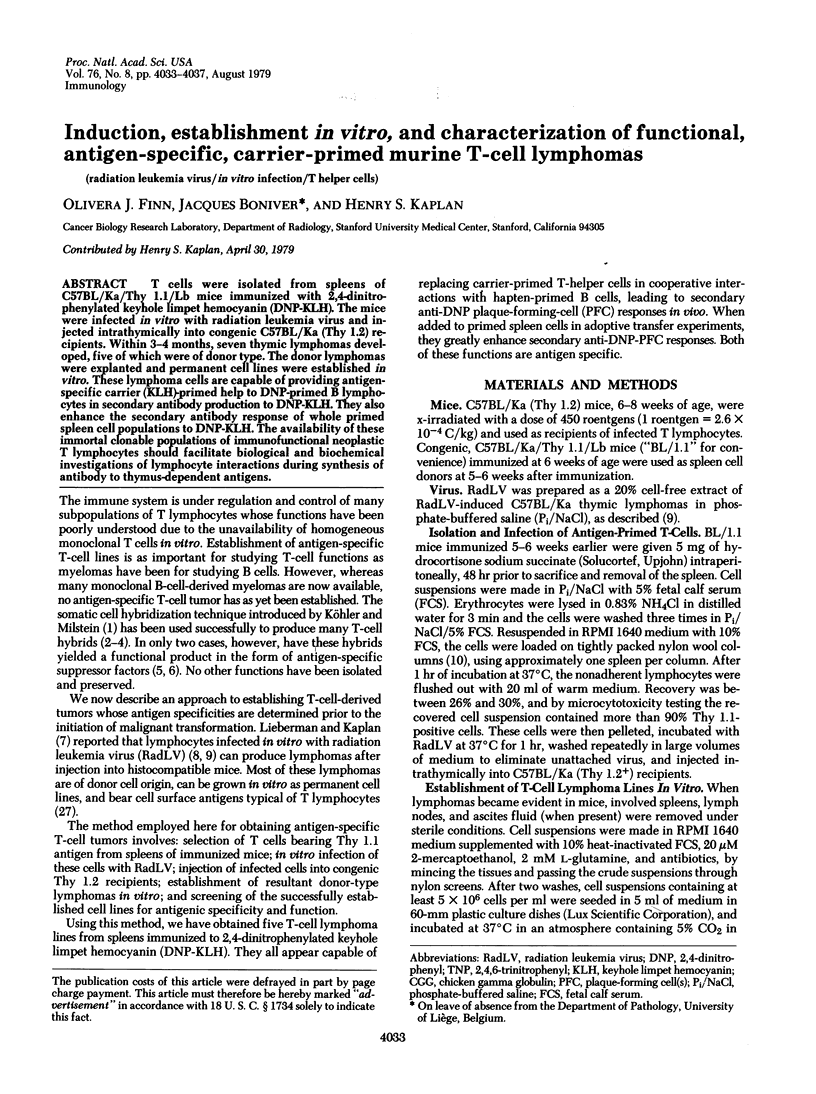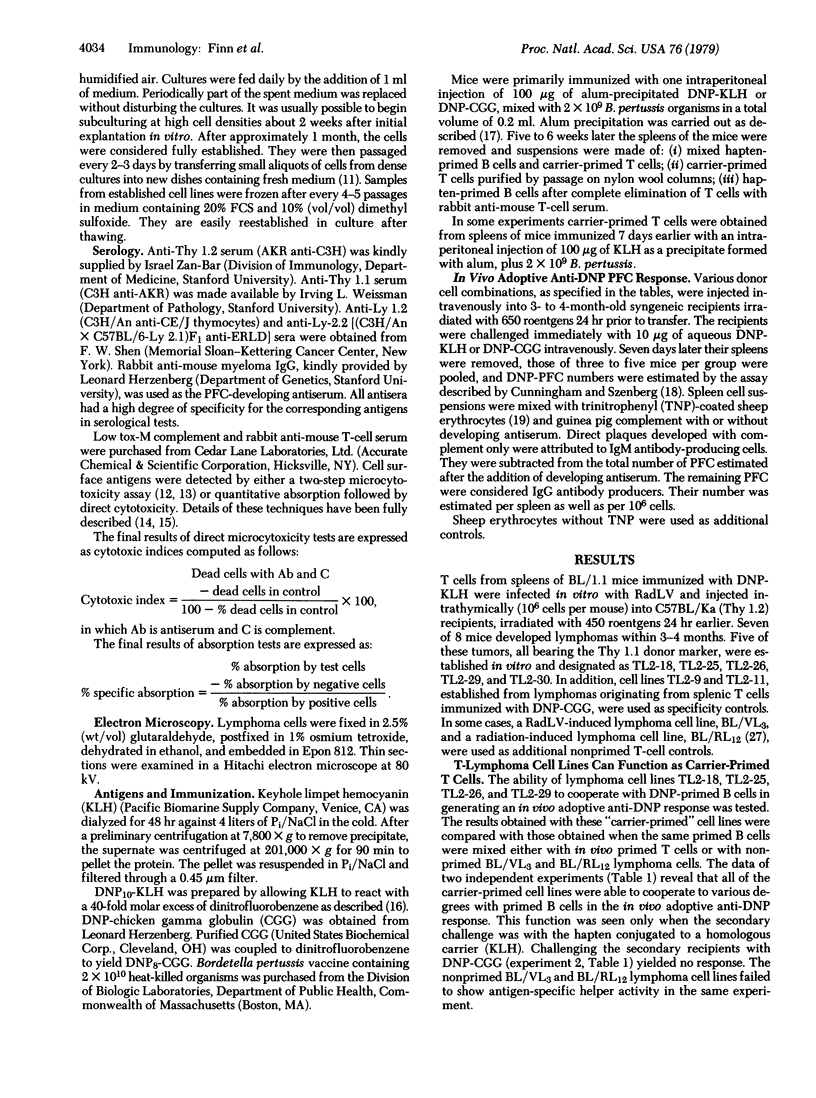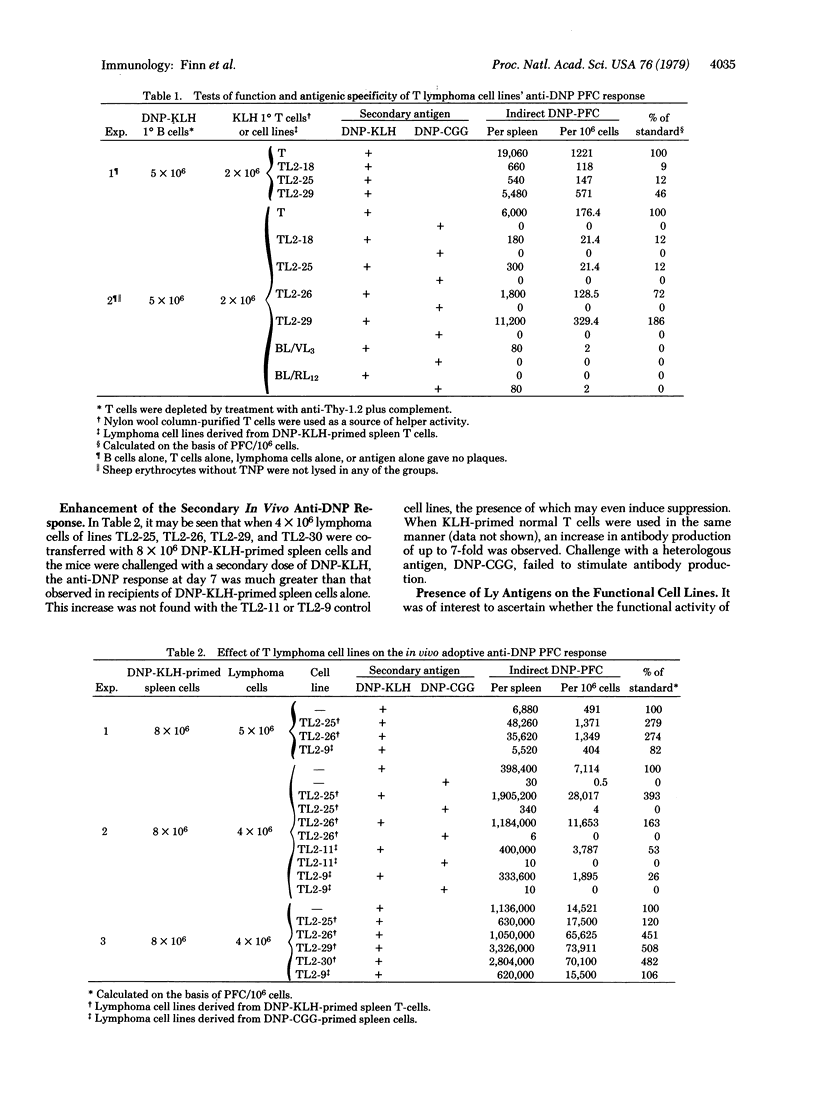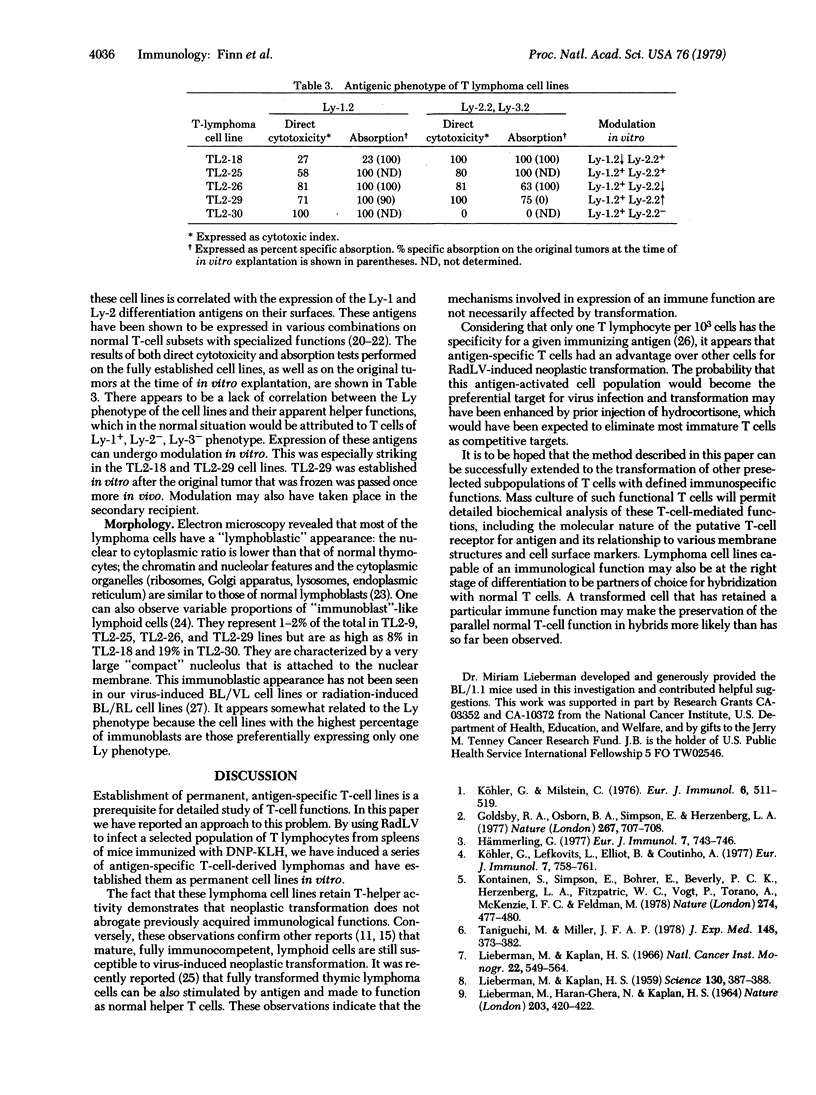Abstract
T cells were isolated from spleens of C57BL/Ka/Thy 1.1/Lb mice immunized with 2,4-dinitrophenylated keyhole limpet hemocyanin (DNP-KLH). The mice were infected in vitro with radiation leukemia virus and injected intrathymically into congenic C57BL/Ka (Thy 1.2) recipients. Within 3-4 months, seven thymic lymphomas developed, five of which were of donor type. The donor lymphomas were explanted and permanent cell lines were established in vitro. These lymphoma cells are capable of providing antigen-specific carrier (KLH)-primed help to DNP-primed B lymphocytes in secondary antibody production to DNP-KLH. They also enhance the secondary antibody response of whole period spleen cell populations to DNP-KLH. The availability of these immortal clonable populations of immunofunctional neoplastic T lymphocytes should facilitate biological and biochemical investigations of lymphocyte interactions during synthesis of antibody to thymus-dependent antigens.
Full text
PDF




Selected References
These references are in PubMed. This may not be the complete list of references from this article.
- Amos D. B., Bashir H., Boyle W., MacQueen M., Tiilikainen A. A simple micro cytotoxicity test. Transplantation. 1969 Mar;7(3):220–223. doi: 10.1097/00007890-196903000-00023. [DOI] [PubMed] [Google Scholar]
- Boniver J., Simar L. J., Couroy R., Betz E. H. Quantitative analysis of thymus lymphoid cells during murine radioleukemogenesis. Cancer Res. 1978 Jan;38(1):52–58. [PubMed] [Google Scholar]
- Cantor H., Boyse E. A. Functional subclasses of T lymphocytes bearing different Ly antigens. II. Cooperation between subclasses of Ly+ cells in the generation of killer activity. J Exp Med. 1975 Jun 1;141(6):1390–1399. doi: 10.1084/jem.141.6.1390. [DOI] [PMC free article] [PubMed] [Google Scholar]
- Cantor H., Boyse E. A. Functional subclasses of T-lymphocytes bearing different Ly antigens. I. The generation of functionally distinct T-cell subclasses is a differentiative process independent of antigen. J Exp Med. 1975 Jun 1;141(6):1376–1389. doi: 10.1084/jem.141.6.1376. [DOI] [PMC free article] [PubMed] [Google Scholar]
- Cantor H., Shen F. W., Boyse E. A. Separation of helper T cells from suppressor T cells expressing different Ly components. II. Activation by antigen: after immunization, antigen-specific suppressor and helper activities are mediated by distinct T-cell subclasses. J Exp Med. 1976 Jun 1;143(6):1391–1340. doi: 10.1084/jem.143.6.1391. [DOI] [PMC free article] [PubMed] [Google Scholar]
- Cunningham A. J., Szenberg A. Further improvements in the plaque technique for detecting single antibody-forming cells. Immunology. 1968 Apr;14(4):599–600. [PMC free article] [PubMed] [Google Scholar]
- Frelinger J. A., Neiderhuber J. E., David C. S., Shreffler D. C. Evidence for the expression of Ia (H-2-associated) antigens on thymus-derived lymphocytes. J Exp Med. 1974 Nov 1;140(5):1273–1284. doi: 10.1084/jem.140.5.1273. [DOI] [PMC free article] [PubMed] [Google Scholar]
- Goldsby R. A., Osborne B. A., Simpson E., Herzenberg L. A. Hybrid cell lines with T-cell characteristics. Nature. 1977 Jun 23;267(5613):707–708. doi: 10.1038/267707a0. [DOI] [PubMed] [Google Scholar]
- Hämmerling G. J., McDevitt H. O. Antigen binding T and B lymphocytes. I. Differences in cellular specificity and influence of metabolic activity on interaction of antigen with T and B cells. J Immunol. 1974 May;112(5):1726–1733. [PubMed] [Google Scholar]
- Hämmerling G. J. T lymphocyte tissue culture lines produced by cell hybridization. Eur J Immunol. 1977 Oct;7(10):743–746. doi: 10.1002/eji.1830071018. [DOI] [PubMed] [Google Scholar]
- Julius M. H., Simpson E., Herzenberg L. A. A rapid method for the isolation of functional thymus-derived murine lymphocytes. Eur J Immunol. 1973 Oct;3(10):645–649. doi: 10.1002/eji.1830031011. [DOI] [PubMed] [Google Scholar]
- Kim K. J., Weinbaum F. I., Mathieson B. J., McKeever P. E., Asofsky R. Characteristics of BALB/C T cell lymphomas grown as continuous in vitro lines. J Immunol. 1978 Jul;121(1):339–344. [PubMed] [Google Scholar]
- Kontiainen S., Simpson E., Bohrer E., Beverley P. C., Herzenberg L. A., Fitzpatrick W. C., Vogt P., Torano A., McKenzie I. F., Feldmann M. T-cell lines producing antigen-specific suppressor factor. Nature. 1978 Aug 3;274(5670):477–480. doi: 10.1038/274477a0. [DOI] [PubMed] [Google Scholar]
- Köhler G., Lefkovits I., Elliott B., Coutinho A. Derivation of hybrids between a thymoma line and spleen cells activated in a mixed leukocyte reaction. Eur J Immunol. 1977 Nov;7(11):758–761. doi: 10.1002/eji.1830071103. [DOI] [PubMed] [Google Scholar]
- Köhler G., Milstein C. Derivation of specific antibody-producing tissue culture and tumor lines by cell fusion. Eur J Immunol. 1976 Jul;6(7):511–519. doi: 10.1002/eji.1830060713. [DOI] [PubMed] [Google Scholar]
- LIEBERMAN M., HARAN-GHERA N., KAPLAN H. S. POTENTIATION OF VIRUS LEUKAEMOGENESIS IN C57BL MICE BY X-IRRADIATION OR URETHANE. Nature. 1964 Jul 25;203:420–422. doi: 10.1038/203420b0. [DOI] [PubMed] [Google Scholar]
- LIEBERMAN M., KAPLAN H. S. Leukemogenic activity of filtrates from radiation-induced lymphoid tumors of mice. Science. 1959 Aug 14;130(3372):387–388. doi: 10.1126/science.130.3372.387. [DOI] [PubMed] [Google Scholar]
- Lieberman M., Kaplan H. S. Lymphoid tumor induction by mouse thymocytes infected in vitro with radiation leukemia virus. Natl Cancer Inst Monogr. 1966 Sep;22:549–557. [PubMed] [Google Scholar]
- Miller J. F., Sprent J. Cell-to-cell interaction in the immune response. VI. Contribution of thymus-derived cells and antibody-forming cell precursors to immunological memory. J Exp Med. 1971 Jul 1;134(1):66–82. doi: 10.1084/jem.134.1.66. [DOI] [PMC free article] [PubMed] [Google Scholar]
- Ricciardi-Castagnoli P., Lieberman M., Finn O., Kaplan H. S. T-cell lymphoma induction by radiation leukemia virus in athymic nude mice. J Exp Med. 1978 Nov 1;148(5):1292–1310. doi: 10.1084/jem.148.5.1292. [DOI] [PMC free article] [PubMed] [Google Scholar]
- Rittenberg M. B., Pratt K. L. Antitrinitrophenyl (TNP) plaque assay. Primary response of Balb/c mice to soluble and particulate immunogen. Proc Soc Exp Biol Med. 1969 Nov;132(2):575–581. doi: 10.3181/00379727-132-34264. [DOI] [PubMed] [Google Scholar]
- Roder J. C., Tyler L., Singhal S. K., Ball J. K. Are T-cell lymphomas immunocompetent? Nature. 1978 Jun 15;273(5663):540–541. doi: 10.1038/273540a0. [DOI] [PubMed] [Google Scholar]
- Taniguchi M., Miller J. F. Specific suppressive factors produced by hybridomas derived from the fusion of enriched suppressor T cells and a T lymphoma cell line. J Exp Med. 1978 Aug 1;148(2):373–382. doi: 10.1084/jem.148.2.373. [DOI] [PMC free article] [PubMed] [Google Scholar]
- Tokuyasu K., Madden S. C., Zeldis L. J. Fine structural alterations of interphase nuclei of lymphocytes stimulated to grwoth activity in vitro. J Cell Biol. 1968 Dec;39(3):630–660. doi: 10.1083/jcb.39.3.630. [DOI] [PMC free article] [PubMed] [Google Scholar]


